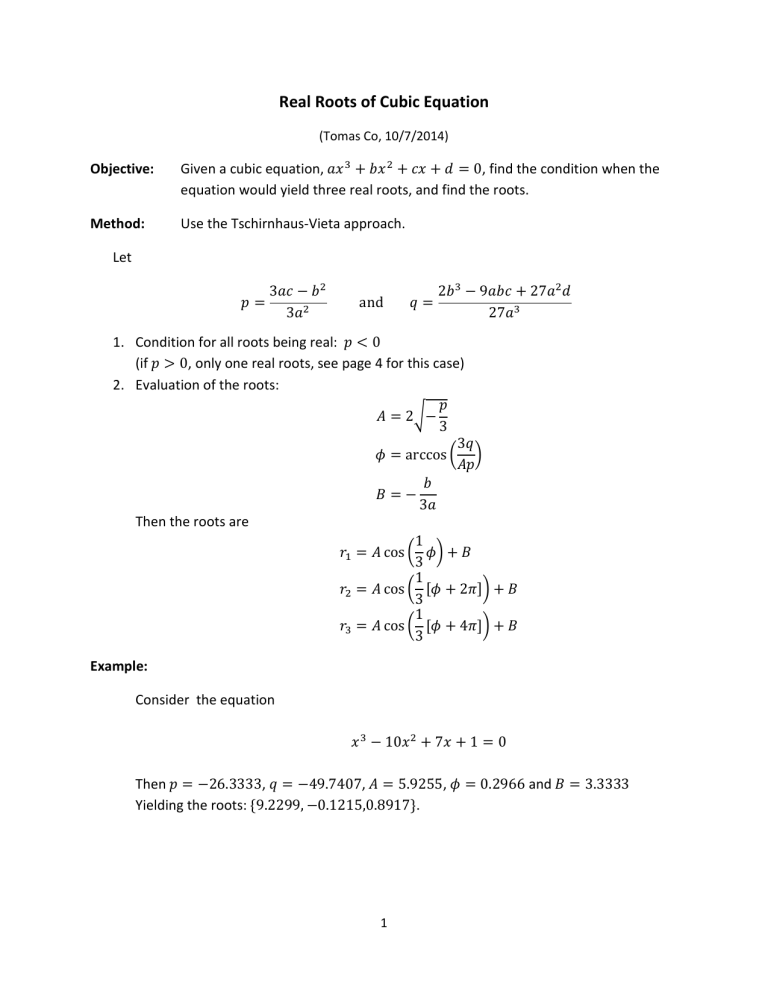Real Roots of Cubic Equation

Real Roots of Cubic Equation
(Tomas Co, 10/7/2014)
Objective: Given a cubic equation,
+ + + = 0
, find the condition when the equation would yield three real roots, and find the roots.
Method: Use the Tschirnhaus-Vieta approach.
Let
=
3 −
3
and =
2 − 9 + 27
1.
Condition for all roots being real:
< 0
(if
> 0
, only one real roots, see page 4 for this case)
2.
Evaluation of the roots:
27
= 2−
3
= arccos
3
! = −
3
Then the roots are
"
#
= cos
1
3 + !
" = cos
1
" = cos
3 % + 2&' + !
1
3 % + 4&' + !
Example:
Consider the equation
− 10 + 7 + 1 = 0
Then
= −26.3333
,
= −49.7407
,
= 5.9255
,
= 0.2966
and
! = 3.3333
Yielding the roots:
{9.2299, −0.1215,0.8917}
.
1
Derivation of Formulas:
1.
First, reduce the cubic equation to a “depressed cubic” equation.
Let
= 0 + !
, then the original equation becomes
0 + 3! +
0
+ 3!
+
+ 2!
0 + 1!
+
!
+ ! +
By setting
! = −/(3)
, the coefficient of
0
becomes zero, yielding
2 = 0
0 + 0 + = 0 where
= (3 − )/(3 ) and
= (2 − 9 + 27 )/(27 )
.
2.
Next, consider the following trigonometric identity cos(36) = cos(26) cos(6) − sin(26) sin(6)
= (cos(6) − sin(6) ) cos(6) − (2 sin(6) cos(6)) sin(6)
= cos(6) − 3 cos(6) sin(6)
= cos(6) − 3 cos(6) (1 − cos(6) ) cos(36) = 4 cos(6) − 3 cos(6)
Or
4 cos(6) − 3 cos(6) − cos(36) = 0
3.
Transform the reduced cubic (1) to match the trigonometric identity (2).
Let
0 = cos(6)
and substitute to (1) to obtain cos(6) + cos(6) + = 0
Then multiply the equation by
4/
to match the first term in (2),
4 cos(6) +
4 cos(6) +
4
= 0
(1)
(2)
To continue to match with (2), we need
4
= −3 → = 2−
3
This yields,
4 cos(6) − 3 cos(6) −
3
= 0
2
So comparing with identity (2), we conclude that cos(36) =
3
Due to the periodicity of cosines, we have three distinct solutions for
6
if we let
= arccos
3 and set
36
#
=
, 3
6 = + 2&
and
36 = + 4&
, or cos(6
#
) = cos
3 ; cos(6
) = cos
+ 2&
3 ; cos(6
) = cos
+ 4&
3
4.
Transform back to the desired solution for .
= 0 + ! = cos(6) + !
That is, the roots are
"
#
= cos(6
#
) + ! = cos
" = cos(6 ) + ! = cos
" = cos(6 ) + ! = cos
3 + !
+ 2&
3 + !
+ 4&
3 + !
Note: Since
= 2:−/3
, we need
< 0
to have be real. Further, with real we will also have
= arccos(3/())
be real.
3
If
; > <
, only one Real Root:
̅ = 2
3
> = asinh 1
3
̅2
"
#
= −2
3 sinh 1
>
32
4



